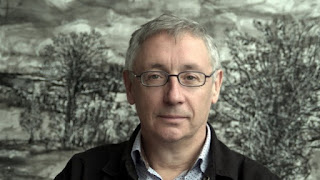 |
| Kevin Volans - Photograph: Nick Miller/PR |
Reviewed by Hilary Glover on May 22 2015
Star rating:
A programme around Kevin Volans second string quartet
Last night (22nd May) the Minimalism Unwrapped series at King's Place continued to unfold with the Duke Quartet's exploration of Kevin Volans' 1987 work 'String Quartet No. 2 Hunting:Gathering' and supporting works by Gavin Bryars, Max Richter, their own John Metcalfe, and John Tavener.
The quartet consists of Louisa Fuller (violin), Rick Koster (violin - also Smith Quartet who performed the European Mavericks at Kings Place last month), John Metcalfe (viola), and Sophie Harris (cello). They have been playing together for more than 17 years and play across Europe, and the world, working with contemporary composers including Kevin Volans, but they have also collaborated with pop musicians such as Morrissey, The Pretenders, Blur, Catatonia, Simple Minds, The Cranberries, Pete Doherty, and The Corrs, and with the dance company Rosas.
Their 2002 album of Volan's compositions ('Hunting:Gathering') received a Gramophone Award nomination, and their latest CD includes Steve Reich's 'Different Trains' which they performed last year at King's Place – a review can be found here.
Kevin Volans (1949-) was born in Pietermaritzburg, South Africa, and, after studying music at the University of Witwatersrand and the University of Aberdeen, he worked with Karlheinz Stockhausen in Cologne. He became interested in using African compositional techniques and, for the next twenty years, focussed on incorporating elements of African style and tuning into contemporary composition.
The idea behind the beautifully haunting 'Hunting:Gathering' is one of eclecticism, and was written for the Kronos Quartet. In it Volans uses many different musical fragments, each representing or referencing different musical styles are eras, each in a different key, but held together as a 'pseudo narrative' – a journey in which no one element is more important than the others. Fragments include African music from the Hamar of South Ethiopia, Xhosa, Lesotho, kora music from Mali, a Shona tune (from Zimbabwe – you can practically hear the thumb piano), as well as European influences such as Scarlatti, Handel, Stravinsky, and his own work.
Gavin Bryars (1943-) is also interested in popular music and started his musical career improvising jazz bass. He worked with John Cage, Cornelius Cardew and John White in the US before returning to the UK. His first string quartet was written in 1985 but tonight's was the second - 'String Quartet no.2 (1990).
Like the Volans, Bryars used blocks of differing styles, tempo, texture, and instrumentation, starting with a ghost of a tune high in harmonics. This was followed by a more traditional romance led by violin I, which in turn was contrasted with a rhythmic rocking from the viola and a cello pedal. A strongly rhythmic section with scrubbing accents and controlled cord changes stood out in its tenseness, as did a section highlighted by trills and grace notes. Nicely balanced, this piece made the most of constantly changing texture and pressure to maintain interest.
Max Richter (1966-) studied music at the Royal Academy of Music and then with Luciano Berio in Italy. Like Volans and Bryars he is interested in popular music including punk and electronica and with reusing and referencing older music - his recent recomposition of Vivaldi's four seasons was reviewed here.
'Infra 8' (2010) is one of 13 movements from the Ballet 'Infra' written for the Royal Opera House and scored for string quartet, piano and electronics (although 'Infra 8' is for string quartet alone). At three minutes long this work is very sweet. A repeating eight-note motif in the viola centres the piece while the other instruments provide harmony and counterpoint with pedal and tenor lines.
John Metcalfe's (1946-) 'As she fell' was originally written for string quartet and guitar and was inspired by the death of his mother. A rhythmic tune develops with differing instrumentation and by addition and subtraction, into something more, but with an incomplete ending which leaves you waiting for the next repetition. You can hear a piano version here.
The concert of post minimalism ended with John Tavener's (1944-2013) 'Hidden Treasure' - also a commemoration work. Tavener described it as being a Byzantine palindrome of 25 notes which represent a journey from Paradise, from which we have fallen, to the Paradise of the Promised Land. In it he has also depicted the Passion and Resurrection of Christ.
Despite 25 minutes of 25 notes, Tavener keeps textural interest by changing the sound quality with judicious use of mutes and by the use of renaissance and baroque techniques such as drones, parallel lines, contra-motion and canon. The Duke quartet provided some lovely moments such as when the violin was in high position on the G string, or the violin and cello in tight canon.
Minimalism Unwrapped continues all year and in July King's Place will be again hosting Tête à Tête opera festival. For more information see their website.
Reviewed by Hilary Glover
Elsewhere on this blog:
- Superb musical values: Cosi fan tutte at Garsington - opera review
- Warm and witty: Jonathan Dove's Flight at Holland Park - opera review
- Purity and beauty: Stile Antico at Spitalfields - concert review
- Vivid colours: Handel Israel in Egypt at Spitalfields Music Summer Festival - concert review
- Highly imaginative: Isis Ensemble, Jacques Cohen - CD review
- A triumph: Puccini's Il Trittico at Opera Holland Park - opera review
- Vibrant ensemble: Wolf-Ferrari's I gioielli della Madonna in Bratislava - Opera review
- East of Tallinn: Orient Music Festival - conference report
- Surrender: Ilona Domnich in an imaginative opera arias recital - CD review
- Bach Pilgrimage revisited: Cantatas volume 8, John Eliot Gardiner - CD review
- Myth and magic: Andrew Griffiths & Londinium - concert review
- Stunning display: Tallinn Chamber Orchestra in Cardiff - concert review
- Home









%20as%20Leporello%20and%20Erik%20Tofte%20(back%20to%20camera%20in%20garnet%20shirt)%20as%20Giovanni%20-%20Don%20Giovanni.jpg)

No comments:
Post a Comment